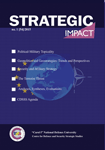POST-COLD WAR EVOLUTION OF THE MILITARY ORGANISATION
POST-COLD WAR EVOLUTION OF THE MILITARY ORGANISATION
Author(s): Costinel NiţuSubject(s): Security and defense, Military policy, Cold-War History
Published by: Carol I National Defence University Publishing House
Keywords: action; fight; environment; military organisation; war; security;
Summary/Abstract: The End of the Cold War surprised and generated confusion within the international public opinion and security organizations. Mankind was facing a new global architecture in which democracy spread rapidly, requiring a reconsideration of the role of international institutions in providing global security. The events that followed influenced and even led to the transformation of the military in order to adapt it so as to fulfill its fundamental mission – military security. The disappearance of the main global security axis meant a challenge, but also an opportunity for the key actors on the global stage. The most urgent issues at that time regarding global security were who would have the capacity to provide, manage, and supervise it and how they would do that. Following the aftermath limitations of the large-scale intensity military threats, many states analyzed and planned the implementation of changes in the defense strategies segment, and also doctrinal changes in support of military actions. Military structures, as key elements involved in war and crisis response situations, changed their physiognomy, so they gradually became smaller, flexible, mobile, modular, self-sustainable, with highly combative capacity, suitable to conduct military actions away from the home-base, in diverse geophysical and psychosocial environments. The place of mass armies was taken by professionalized structures involved in solving various tasks within political and military alliances/coalitions. The broad and complex modernization process of the military was supported and shaped by technologies specific to the information age.
Journal: Strategic Impact
- Issue Year: 2015
- Issue No: 55
- Page Range: 113-119
- Page Count: 7
- Language: English

